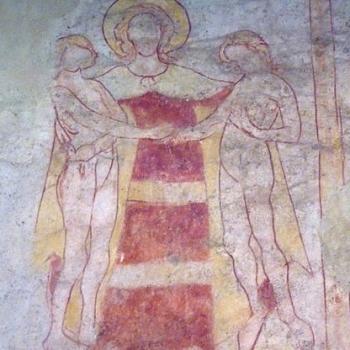 What of grave sin after baptism? Those baptized had an expectation to live holy lives reflective of their new nature. Sin, still a reality in the baptized life, required confession and forgiveness to make the baptized right with God once more (1 John 1:9, James 4:7-8). How did the early Church deal with such sins?
What of grave sin after baptism? Those baptized had an expectation to live holy lives reflective of their new nature. Sin, still a reality in the baptized life, required confession and forgiveness to make the baptized right with God once more (1 John 1:9, James 4:7-8). How did the early Church deal with such sins?
Early Church vs. Martin Luther
This early Christian view of sin stands in stark contrast to the view of sin and justification espoused by Martin Luther and the Reformers in the 16th century. Faith alone as forensic justification makes the need for confession and penance, not only unnecessary, but leaves one more wretched than before (LW 36: 60). To Luther, when God sees the Christian, he sees the righteousness of Christ. See here for my article of Luther and faith alone.
Moreover, early Christians viewed sin in two ways: sin that leads to sickness and sin that leads to death (1 John 5:16, 17). The early Church taught that sins that lead to sickness (venial sins) could and should be confessed and forgiven. Sins that lead to death, on the other hand, were viewed by some early Christian writers (some very educated and influential writers) as unforgivable sins. Sins specifically called out by St. Paul as those sins which, if committed, bars the sinner from the “kingdom of God.” These grave sins were considered mortal. Of note were grave sins of the flesh—adultery and fornication—and sins that involved the rejection of the true God, such as idolatry. The way in which early Christians addressed these grave sins demonstrates that they had no concept of faith alone.
Grave Sin According to St. John
Sacred Scripture is clear that there are two types of sins and what sins are of grave nature and therefore separate one from the kingdom of God. Below are exhortations to the baptized, not those in need of baptism.
1 John 5:16, 17 instructs believers that there are two types of sin: sin that leads to death and sin that does not. St. John is not clear on what these kinds of sins are, but it is clear he thinks they exist.
16 If anyone sees his brother committing a sin not leading to death, he shall ask, and God will give him life—to those who commit sins that do not lead to death. There is sin that leads to death; I do not say that one should pray for that. 17 All wrongdoing is sin, but there is sin that does not lead to death.
Where St. John is not clear, St. Paul offers an exhaustive list of grave sins.
1 Corinthians on Sin
In 1 Corinthians 6:9-10, St. Paul provides more detail on these deadly sins when pleading with the Corinthian church to turn away from grave sin or risk losing the kingdom of God. St. Paul pleads with the baptized, not those yet in sin and in need of the waters of regeneration.
9 Or do you not know that the unrighteous will not inherit the kingdom of God? Do not be deceived: neither the sexually immoral, nor idolaters, nor adulterers, nor men who practice homosexuality, 10 nor thieves, nor the greedy, nor drunkards, nor revilers, nor swindlers will inherit the kingdom of God.
Galatians on Sin
In Galatians 5:19-21, St. Paul again warns the baptized of the dangers of grave sin after baptism. St. Paul expands his list from 1 Corinthians here. We know he is warning the baptized due to his reference to a previous warning. If any Galatians do such things, they will not inherit the kingdom of God.
19 Now the works of the flesh are evident: sexual immorality, impurity, sensuality, 20 idolatry, sorcery, enmity, strife, jealousy, fits of anger, rivalries, dissensions, divisions, 21 envy, drunkenness, orgies, and things like these. I warn you, as I warned you before, that those who do such things will not inherit the kingdom of God.
Ephesians on Sin
Ephesians 5:3-6 invokes God’s wrath on those who commit grave sin. Again, St. Paul is here writing to baptized Christians, not unbaptized pagans. These strong words by St. Paul are what will lead the church into crisis. Can grave sin committed after the regeneration of baptism be forgiven?
3 But sexual immorality and all impurity or covetousness must not even be named among you, as is proper among saints. 4 Let there be no filthiness nor foolish talk nor crude joking, which are out of place, but instead let there be thanksgiving. 5 For you may be sure of this, that everyone who is sexually immoral or impure, or who is covetous (that is, an idolater), has no inheritance in the kingdom of Christ and God. 6 Let no one deceive you with empty words, for because of these things the wrath of God comes upon the sons of disobedience.
St. Paul’s Hope for Grave Sin After Baptism
The only hope St. Paul gives to those who commit grave sin after baptism is found in 1 Corinthians 5:3-5. St. Paul offers the hope that God could save the soul of the sinner at the expense of their body.
3 For though absent in body, I am present in spirit; and as if present, I have already pronounced judgment on the one who did such a thing. 4 When you are assembled in the name of the Lord Jesus and my spirit is present, with the power of our Lord Jesus, 5 you are to deliver this man to Satan for the destruction of the flesh, so that his spirit may be saved in the day of the Lord.
Of course, many of those who adhere to faith alone will claim the introductory scriptural exegesis on the two types of sin is incorrect. They may claim that the writer’s Catholicism read into the passages used and that those passages do not teach mortal and venial sin. In all honesty, those detractors could be right. Scriptural interpretation can, and many times does, lead to different conclusions. This truth is why it is important to also evaluate the historical record. It is important to assess early Christians beliefs and how early Christians lived out those beliefs in everyday life. It is to that record that we turn to now.
Callistus I vs. Hippolytus
It is the year 218 AD. 118 years since the death of the Apostle John (d. 100 AD), sixty-three years since the death of John’s disciple Polycarp (155 AD), and a mere sixteen years since the death of Polycarp’s disciple Irenaeus (202 AD). Pope Zephyrinus has just died, and the church of Rome has just elected a new pope, Callistus I. Hippolytus, a Roman priest and rival to Callistus, flees the city in anger and sets himself up as a rival Bishop of Rome. Hippolytus, the Church’s first truly prolific writers, is the Catholic Church’s first anti-pope. His main disagreement with Callistus: the forgiveness of grave sins of the flesh (fornication and adultery) after baptism. This Callistus had degreed “throughout the entire world.”
Hippolytus the Rigorist
A rigorist (someone who adheres to severe purity and discipline), Hippolytus thought that the church was to be holy and set apart. Those baptized who committed grave sins, such as the afore mentioned sins of the flesh, could only receive forgiven by God alone. Those who committed grave sin were removed from fellowship with the people of God. Moreover, Hippolytus’ critique of Callistus was borne of rivalry and not necessarily theology. Hippolytus’ reconciliation with the church under Pope Pontian in 235 AD, during the Maximinus Thrax persecution, reflects this fact.
“The impostor Callistus, having ventured on such opinions, established a school of theology in antagonism to the Church, adopting the foregoing system of instruction. And he first invented the device of conniving with men in regard of their indulgence in sensual pleasures, saying that all had their sins forgiven by himself. For he who is in the habit of attending the congregation of anyone else, and is called a Christian, should he commit any transgression; the sin, they say, is not reckoned unto him, provided only he hurries off and attaches himself to the school of Callistus. And many persons were gratified with his regulation, as being stricken in conscience, and at the same time having been rejected by numerous sects; while also some of them, in accordance with our condemnatory sentence, had been by us forcibly ejected from the Church.” (Philosophumena Book IX, Chapter VII [220 AD])
Callistus I’s Merciful Approach
Callistus I’s more merciful approach was not contrary to the tradition of penance that had come before. As shown above, bishops (and priests) had the authority to forgive sin. The question was whether grave sins committed after baptism would qualify for forgiveness or not. By declaring that sins like fornication and adultery as forgiven through confession and proper penance, Callistus I put this subject to rest (for the time being). He claimed that the Church exists as both wheat and tares (Matthew 13:24-30)—that the holy exists alongside the sinful. It was therefore the church’s responsibility to provide opportunities for reconciliation of even the most egregious of sins. Callistus I’s clarification regarding the forgiveness grave sins after baptism was considered a theological innovation by not only Hippolytus. The other detractor, Tertullian, disagreed for entirely different reasons.
Callistus I vs. Tertullian
Tertullian is of two minds regarding the forgiveness of grave sin after baptism. Early Tertullian would side more with Callistus I, while the latter Tertullian (the Montanist) sided firmly with Hippolytus’ view, although for very different reasons. Early Tertullian refers to the practice of confession and penance as exomologesis, or public confession, satisfaction (sackcloth and ashes), and eventual reconciliation with the Church. For early Tertullian, to spurn exomologesis was to willfully risk hell.
“Therefore, since you know that after the first bulwarks of the Lord’s baptism there still remains for you, in exomologesis a second reserve of aid against hell, why do you desert your own salvation? Why are you tardy to approach what you know heals you? Even dumb irrational animals recognize in their time of need the medicines which have been divinely assigned them” (Tertullian, On Repentance, Chapter 12 [before 210 AD)).
Tertullian the Montanist
Tertullian the Montanist, writing after 210 AD, revises his previously views on forgiveness of grave sin, especially fornication and adultery, in an indictment against the “bishop of bishops” (Callistus I) for declaring throughout the world forgiveness to those who meet the required terms of repentance.
“I hear that there has even been an edict set forth, and a peremptory one too. The Pontifex Maximus — that is, the bishop of bishops — issues an edict: I remit, to such as have discharged (the requirements of) repentance, the sins both of adultery and of fornication. O edict, on which cannot be inscribed, Good deed! And where shall this liberality be posted up? On the very spot, I suppose, on the very gates of the sensual appetites, beneath the very titles of the sensual appetites.” (Tertullian, On Modesty, Chapter 1 {after 210 AD])
The Discouragement of Sin
Tertullian’s change in position is not due to what he considered an innovation in church practice. He thinks the church has the power to forgive grave sin after baptism. His change in position is due to his acceptance of the Montanist sect. Montanism, a prophetic movement in the early church, asserted superior ecclesial authority on the matter. The Montanist “prophets” withheld this rightful power of the church to discourage further sin. The Paraclete is the Holy Spirit.
“But, you say, the Church has the power of forgiving sins. This I acknowledge and adjudge more (than you; I) who have the Paraclete Himself in the persons of the new prophets, saying, The Church has the power to forgive sins; but I will not do it, lest they commit others withal.”
Tertullian further appeals to Sacred Scripture to justify his new position. In Chapter 20 he states:
“He who learned this from apostles, and taught it with apostles, never knew of any second repentance promised by apostles to the adulterer and fornicator.”
No “Second Repentance”
This refusal to allow a “second repentance” became a battle cry for the rigorous Montanists that viewed their personal prophetic revelation and interpretation of Sacred Scripture as the ultimate authorities on the matter. They, like Hippolytus, viewed the church as set apart and holy. Those who did not fall in line with this view were unworthy and therefore cast out. Not surprisingly, these new outcasts found acceptance and forgiveness in the church of Rome under Callistus I (Philosophumena Book IX, Chapter VII).
An Issue of Grave Sin Revisited
Now, it must be stressed that both Hippolytus (Apostolic Tradition 3 [A.D. 215]) and Tertullian (Repentance 10:1 [A.D. 203]) believed that a bishop (and priests) had the ability to forgive sins, impose penance, and give absolution to the baptized. The disagreement with Callistus I was about grave sin. In their opinions, only God had the prerogative to forgive such grave acts (Hippolytus) and only the “true” prophetical church had the authority (Tertullian), but chose not to do so.
Most telling about this situation is not that Callistus I created a new practice out of whole cloth, but that he enlarged its parameters according to Hippolytus and encouraging sinful behavior through an invalid ecclesial authority by the Montanist Tertullian. Tertullian’s particular criticism is that Callistus I is not a member of the “new prophesy, ” not that a bishop has no authority to forgive sin.
Callistus I vs. Luther
Nowhere does the early record show a correction of Callistus I from a faith alone perspective. There are attempts at correction from a rigorist and Montanist perspective, but none from a faith alone one. The answer to why is a simple one. The concept of faith alone did not exist in the early church.
Martin Luther stated clearly the only unforgiveable sin is unbelief (LW 36: 60). Luther’s overall approach to post-baptismal sin is totally foreign to early Christians. His emphasis on the powerlessness of sin and its inability to cause spiritual harm to the sinner stands at odds with the whole of early Christian thought and struggle with the reality of grave sin after baptism.
“Indeed, Christ once and for all absolved and freed everyone from sin and death when He merited for us the law of the Spirit of the Life. But what did that Spirit of Life do? He has not yet freed us from death and sin, for we still must die, we still must labor under sin; but in the end He will free us. Yet He has already liberated us from the law of sin and death, that is, from the kingdom and tyranny of sin and death. Sin is indeed present, but having lost its tyrannic power, it can do nothing; death indeed impends, but having lost its sting, it can neither harm nor terrify. These then are two places in which Paul calls “sin” that evil which remains after baptism” (Against Latomus,” LW 32, 207).
The Only Unforgivable Sin is Unbelief?
Both Hippolytus and Tertullian fall far short of this understanding by claiming one risks the loss of salvation through a grave sinful act. Martin Luther clearly stated that the only unforgivable sin is unbelief. He claimed that contrition, confession of sins, and satisfaction were exercises that only served me make one more wretched [LW 36: 60]. The crisis over grave sin after baptism stands in opposition to the views of Martin Luther (and the other Reformers). The historical record demonstrates that Callistus I, Hippolytus, and Tertullian are completely unaware of the concept of faith alone.
The Issue Of Grave Sin in Historical Context
As mentioned above, this crisis took place in 218 AD. Irenaeus of Lyon, a disciple of Polycarp, a disciple of John the Apostle, has been dead only sixteen years. It is very likely both Hippolytus and Callistus I knew Irenaeus. If the early church invented confession and penance out of whole cloth, Irenaeus would have known about it and sought to correct it. He did not. He writes of his admiration and respect for the church in Rome.
St. Irenaeus and the Church of Rome
St. Irenaeus, twenty-nine years before the bishopric of Callistus I, writes regarding the authentic authority of the Roman church:
“Church in Rome dispatched a most powerful letter to the Corinthians, exhorting them to peace, renewing their faith, and declaring the tradition which it had lately received from the apostles,…
To this Clement there succeeded Evaristus. Alexander followed Evaristus; then, sixth from the apostles, Sixtus was appointed; after him, Telephorus, who was gloriously martyred; then Hyginus; after him, Pius; then after him, Anicetus. Soter having succeeded Anicetus, Eleutherius does now, in the twelfth place from the apostles, hold the inheritance of the episcopate. In this order, and by this succession, the ecclesiastical tradition from the apostles, and the preaching of the truth, have come down to us. And this is most abundant proof that there is one and the same vivifying faith, which has been preserved in the Church from the apostles until now, and handed down in truth.” (Against Heresies (Book III, Chapter 3 [between 174 and 189 AD])
The Historical Record Stands Against Faith Alone
The historical record is clear: early Christians had no concept of faith alone as forensic justification. Clearly, the way early Christians lived out their faith and the way they internally fought over issues of faithfulness, such as grave sin after baptism, shows a total lack of understanding in regards to faith alone. All evidences continually points away from this 16th century innovation.
Like what you read? Please check out my other writing here.
Please like and follow me on Facebook.











